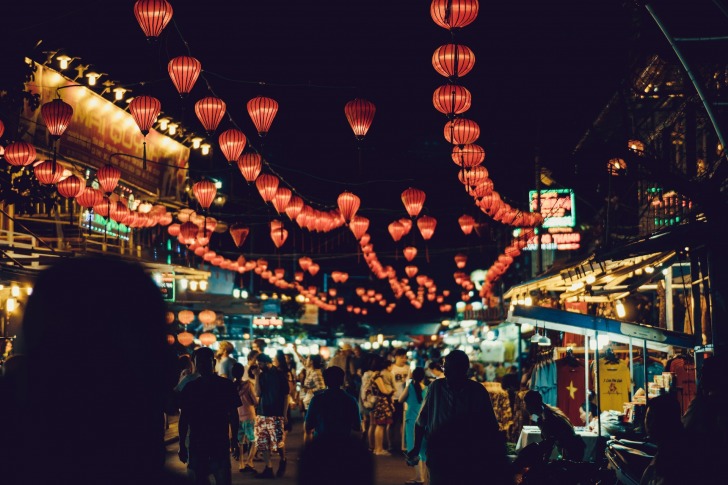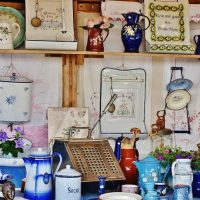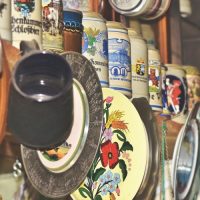If you plan a trip to Vietnam, your itinerary should include at least one flea market.
The markets are among the most well-liked tourist spots in the nation because they give visitors an intimate look at the community’s culture in an authentic Vietnamese environment.
The flea markets come to life in the morning or evening, which means any time can be shopping time.
Contents
13 Best Flea Markets in Vietnam
1. Central Market
The central market is one of the most loved flea markets in Vietnam.
Vendors are always on their toes attending to clients.
Any time of the day, you can see the constant bustle that characterizes the locals’ daily existence.
Although their products are of good quality and there are many different items to choose from nearby, it could be challenging to haggle for a fair price if you are not Vietnamese or do not speak the language.
The whole sales process is enjoyable as it lets you pick up a few Vietnamese words here and there.
2. Hoi An market
Located in the city’s center, on Nguyen Hoang Street, this flea market offers a range of authentic Vietnamese foods, souvenirs, jewelry, and accessories and hosts over 50 local business owners.
Hoi An is also strategically located on a 300-meter-long promenade that borders the Thu Bon River and is lit up by many beautiful lanterns, rendering it a beautiful and popular setting for photography.
Make sure to carry your A game in bargaining when visiting the market.
Bargaining helps you get a better price and makes the adventure in the market more exciting.
3. Dong Xuan Market
The largest indoor market constructed in French-style architecture, Dong Xuan Market, is tucked away in the core of the Old Quarter.
Three floors of this market house various selling sections with a vast range of items carefully organized.
Here, you may buy everything from any part of Vietnam for a fair price, including clothes, jewelry, handbags, traditional knickknacks, and sand paintings.
Explore Dong Xuan Alley for various regional meals and snacks.
The vendors in this market are the kindest and most polite people you may find.
Be sure to carry your camera and capture the memories.
4. Weekend Night Market
On Saturday and Sunday nights, crowds of visitors and residents explore the diverse stalls stocked with souvenirs, apparel, shoes, and accessories.
Weekend Night Market extends from Hang Dao Street to the edge of Dong Xuan Market, so be sure to be fully energized for a night of shopping and exploring.
You will pay a price far less than what you would pay if you made your purchase in the nearby stores during the day.
But in Hanoi, haggling and negotiation are both expected and regarded as fun aspects of the purchasing process.
While the market is a prime place for shopping, it is also great to meet up with friends and unwind after a long day at work or take in the city’s sights.
5. Cho Hom Market
Being Hanoi’s primary fabric market, Cho Hom Market is not only best suited for fabric shopping but also for learning about regional customs and culture.
Walking among the market’s many colorful stalls that sell a range of goods beside fabric is fun and educative.
On the first floor, there are a lot of well-organized kiosks selling a wide range of products.
The market’s second floor hosts the fabric haven with a vast assortment of colorful and unique fabric options.
While the fabrics in the market vary in designs and types, the constant similarity is their high quality.
6. Hang Be Market
Hang Be has been a significant part of the Vietnamese capital for a century.
The market is always packed with people because they believe the food sold there has better flavor than in other places.
Even though Hanoians know this idea is subjective and not entirely accurate, it has embedded itself profoundly in their thoughts and does not seem to change any time soon.
Over the years, even with constant technological advancement, Hang Be has been unchanged and still lives by the same culture.
Each vendor has a predetermined position, leaving little to no room for them to get into a tiff over space.
7. Saigon Flea Market
Since this is where local and foreign artisans share their love of creating handcrafted goods and vintage apparel with the community, which explains the common nickname “Market of Artists.”
Phu My Hung is one of the town’s most peaceful and enjoyable areas since there are not any terrible traffic beeps and honks occasionally driving you nuts.
Saigon Flea Market, situated on the Boomerang restaurant’s first floor, has a lovely river view.
Compared to other flea markets, the Saigon Flea Market’s products are exceptionally unique and affordably priced.
You may get fantastic jewelry, vintage items, and many charming home decor items here.
8. Hello Weekend Market
You can purchase anything from clothing to accessories, cosmetics, and household goods at Hello Weekend Market.
The popularity of this market explains why many new brands and online retailers come to this flea market to network with prospective clients.
You have a great chance to discover products you love that the broader public has not yet heard of and get goods from well-known regional brands.
This market sells both brand new and second-hand products.
The vendors are very cautious of the products they sell to their customers, so do not have second thoughts about getting a second-hand product.
9. Ben Thanh Market
Ben Thanh Market, possibly the most well-known in Vietnam, is the most ancient market in Saigon.
The building offers numerous product categories and two unique stories.
Visitors and locals alike observe this large market for buying and selling.
Although it can be challenging to get between the packed crowds, countless shops, and lanes, vendors are ready to offer you some delicious delicacies to rejuvenate you throughout your shopping day.
The beauty of Ben Thanh is that each sell has very different products from the others.
All their products are unique, high quality, and extremely visually pleasing.
10. Dan Sinh
By placing numerous modest shops selling basics adjacent to one another, the Dan Sinh Market brilliantly reflects the traditional essence of Vietnam.
Visitors to Dan Sinh market will get a chance to see Saigon’s busy retail scene and its fast-paced way of life.
The majority of the products on the market are second-hand products.
As a continual reminder of a bygone era from the illustrious period of Vietnamese ancestors, this market in Saigon used to sell second-hand U.S. military equipment.
It has also become a popular destination for people who enjoy antiques where they can pick up souvenirs.
11. Ba Chieu market
The Ba Chieu market in Saigon, which has over 800 business families and 40 categories, is a well-known shopping area because of its quantity, high standards, and reasonable prices.
Furthermore, you are always welcome in this renowned Ho Chi Minh City market, regardless of how much you purchase.
You can always count on salespeople to give you a friendly smile and thoughtful advice.
This market is also great for learning about the rich Vietnamese culture.
12. Bac Ha Market
Among Southeast Asia’s finest ethnic markets, Bac Ha is located in the highlands of northern Vietnam.
Bac Ha is popular because it is accessible and inexpensive and offers an unmatched quality of products.
Bac Ha is a unique market because it is one of the few markets where cattle, horses, and buffalo selling is still up and running.
This market has single-handedly sustained the buffalo, horses, and cattle selling, which helps support the country’s economy and maintain the rich culture.
The market’s structure mirrors a small-town county fair in rural North America for the minority community
13. Binh Tay Market
The biggest Chinatown district in Vietnam is where you’ll find the Binh Tay market.
The French built the two-story building in the 1880s, an exemplary illustration of French design.
While this market’s handicrafts, textiles, and lacquerware range are not as large as those in other downtown Hanoi marketplaces, it offers a wide variety.
The Binh Tay market draws visitors who want to experience the local way of life and enjoy distinctive Vietnamese-Chinese cuisine and its cultural and historical significance.
The 13 Best Flea Markets in Vietnam – Summary Table
| Flea Market | Address |
|---|---|
| 1. Central Market | 4 Phạm Ngũ Lão, Phường Phạm Ngũ Lão, Quận 1, Thành phố Hồ Chí Minh, Vietnam |
| 2. Hoi An market | 19 Trần Phú, Cẩm Châu, Hội An, Quảng Nam, Vietnam |
| 3. Dong Xuan Market | 2RQX+6Q5, Đồng Xuân, Hoàn Kiếm, Hà Nội, Vietnam |
| 4. Weekend Night Market | 8 Hàng Đào, Hoàn Kiếm, Hà Nội, Vietnam |
| 5. Cho Hom Market | 79 P. Huế, Ngô Thì Nhậm, Hai Bà Trưng, Hà Nội, Vietnam |
| 6. Hang Be Market | 4 Nguyễn Thiện Thuật, Hàng Bạc, Hoàn Kiếm, Hà Nội, Vietnam |
| 7. Saigon Flea Market | 1st floor 107 Tôn Dật Tiên Tân Phong, Quận 7, Thành phố Hồ Chí Minh 700000, Vietnam |
| 8. Hello Weekend Market | 02 Đ. Đinh Tiên Hoàng, Đa Kao, Quận 1, Thành phố Hồ Chí Minh, Vietnam |
| 9. Ben Thanh Market | Đ. Lê Lợi, Phường Bến Thành, Quận 1, Thành phố Hồ Chí Minh, Vietnam |
| 10. Dan Sinh | Số 104, Yersin, Phường Nguyễn Thái Bình, Quận 1, Hồ Chí Minh 700000, Vietnam |
| 11. Ba Chieu market | 40 DIEN HONG STREET, WARD 1, BINH THANH DISTRICT, Ho Chi Minh City, Vietnam |
| 12. Bac Ha Market | G7MV+X48, TT. Bắc Hà, Bắc Hà, Lào Cai, Vietnam |
| 13. Binh Tay Market | 57A Tháp Mười, Phường 2, Quận 6, Thành phố Hồ Chí Minh 700900, Vietnam |
Vietnam Safety Overview
READ THE FULL REPORT: Vietnam Safety Review
Safety Index:
- OVERALL RISK: LOW
- TRANSPORT & TAXIS RISK: MEDIUM
- PICKPOCKETS RISK: MEDIUM
- NATURAL DISASTERS RISK: MEDIUM
- MUGGING RISK: LOW
- TERRORISM RISK: LOW
- SCAMS RISK: MEDIUM
- WOMEN TRAVELERS RISK: MEDIUM
Frequently Asked Questions
Which activities are not present in Vietnamese flea markets?
In Vietnam, there are laws against gambling, drug use, sale, and pornography, to name just a few.
If you are caught engaging in any illegal activities, this may cause severe problems with the law enforcers.
What does crossing your fingers mean in Vietnam?
In most cultures, crossing your fingers denotes good fortune.
But not in Vietnam.
Since it is thought to resemble female genitalia, performing the gesture is comparable to giving the middle finger.
Can you use your index finger to point at something?
Pointing with your index finger is considered disrespectful in Vietnam.
Use your pinky finger to indicate where you want to point politely.











